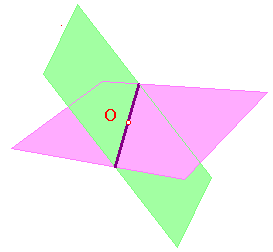
Homogeneous coordinates
The introduction of ideal points provides many advantages,but it means we can no longer represent a point by its cartesian coordinates.
 To allow us to use algebraic methods to study the euclidean plane with ideal points,
To allow us to use algebraic methods to study the euclidean plane with ideal points,
we need a new model. We begin with a purely formal definition of a new geometry,
which we call RP2.
Definition 1
The set RP2 consists of all objects of the form
[u] = {ku, k non-zero},
where u = (u,v,w) is a non-zero vector. The elements are
RP2-points
.
For any choice of k, the triple (ku,kv,kw)
are homogeneous coordinates for U.
In other words, an element of RP2 is a line through the origin O
in R3 (but with O deleted).
Note that [u] = [v] if and only if they give the same line, i.e.
u=kv, for some non-zero k.

Definition 2
If U = [u] and V = [v] are RP2-points,
then the RP2-line UV is defined to be
the set
{ku + lv, k,l not both zero}
Then, in R3, UV is the plane through O generated by u and v (but with O deleted).
Thus an RP2-line has equation
of the form ax + by + cz = 0.
 Now suppose that L and M are distinct RP2-lines.
Now suppose that L and M are distinct RP2-lines.Then the defining planes in R3 intersect (since each is through O),
and so meet in a line through O, i.e. in an RP2-point.
Thus, the incidence rules for the geometry RP2 are,
two RP2-points define an RP2-line,
two RP2-lines define an RP2-point.
These are exactly the same as those of the euclidean plane with ideal points!
In fact the two geometries are very closely related indeed.
As usual, we introduce x,y coordinates on E.
Now the clever bit - we think of E as lying on the plane z=1 in R3,
so the point (a,b) on E lies on (a,b,1).
Let P be the point (a,b) on E.
Then P lies on the RP2-point [(a,b,1)]. Thus,
each point of E defines an
RP2-point with non-zero third coordinate.
Now suppose that the lines L and M lie on E and are parallel.
As parallel lines on E, they must have equations ax + by + c =0 and ax + by + c' = 0.
It is easy to see that L and M are, respectively,
the intersections of
ax + by + cz =0 and of ax + by + c'z =0 with z=1.
Now, where ax + by + cz =0 and ax + by + c'z =0 intersect, we have
ax + by = 0 and z=0. These define the RP2-point [(b,a,0)], so
each family of parallel lines on E defines an RP2-point
with third coordinate zero.
But a family of parallel lines on E correspond to an ideal point of E, so
each ideal point for E defines an RP2-point
with third coordinate zero.
Thus, the points of RP2 correspond to those of Ê.
Lines in RP2.
Let L be an RP2-line with equation ax + by + cz = 0.- if a and b are not both zero, then L meets z=1 in the line
ax + by + c = 0, z=1,
so L meets E in the euclidean line ax + by + c = 0.
Also, L meets z=0 in the line ax + by = 0, z=0. This is the RP2-point [b,-a,0].
In this case, L corresponds to a line of E, together with its ideal point. - if a=b=0, then L is z=0, so corresponds to the set of ideal points of E,
i.e. to the ideal line for E.